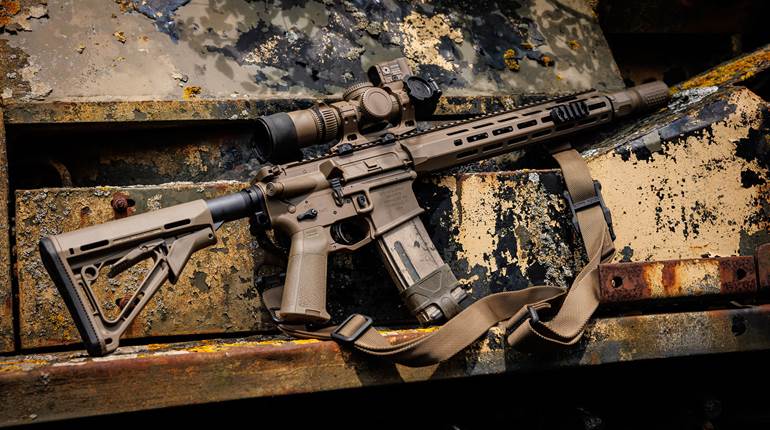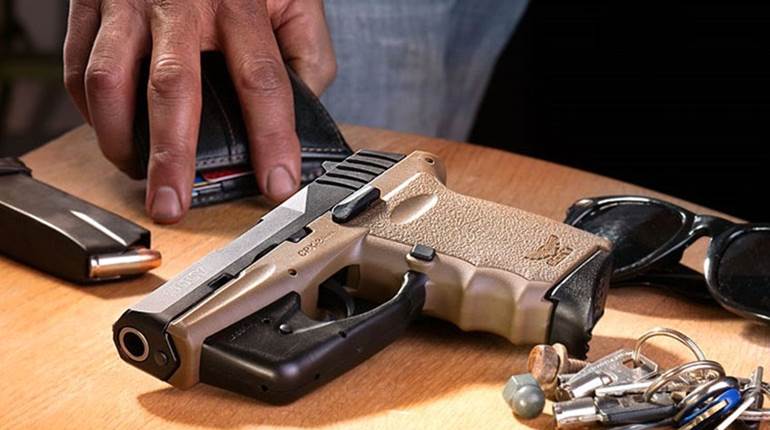
Operations in Iraq and Afghanistan have brought back what some thought were obsolete combat tactics. Until recently, the emphasis on small arms has been up close and personal, with practical ranges being less than 300 meters. For that role, the 5.56x45 mm NATO cartridge has been more than sufficient. The topography of the deserts and mountains of Iraq and Afghanistan, however, have reintroduced long-range combat, and NATO troops need rifles to effectively engage targets at ranges from 400 to 1,000 meters. While the U.S. Army has turned to the M14-based Enhanced Battle Rifle and Designated Marksman Rifle, the British opted for a different solution.
In December 2009 the British Ministry of Defense issued an urgent operational requirement for a 7.62x51 mm NATO semi-automatic rifle that could effectively eliminate targets from 500 to 800 meters. The gun was to perform the role of a sharpshooter rifle, as well as have the ability to be used in close-quarters battle conditions, including rapid tactical fire. This was of particular importance to British forces in Afghanistan. In the British Army, sharpshooters are one step down from full-fledged snipers.
Although the Accuracy International L96 bolt-action is suitable for a sniper, the sharpshooter may end up in situations where more rapid firepower is needed. The British wanted a modern rifle that was a significant improvement over the FN-FAL-based Self-Loading Rifle issued to British troops prior to the adoption of the L85A1 bullpup in 5.56x45 mm NATO. The competition was fierce, and many of the top modern riflemakers competed, including Heckler & Koch (H&K), Fabrique Nationale (FN), Knights Armament Co. (KAC), Sabre Defence, Oberland Arms and Lewis Machine & Tool (LM&T). The final two entrants in the trial were the LM&T LM7 and H&K 417.
The testing protocol was different from the U.S. Army and Marine requisites. American rifles, such as the Knights Mk 11 and the M110 SASS (both in the SR-25 family), were developed around match-grade ammunition (M118 and M118LR), which restricts interchangeability with standard M80 ball. The British wanted their rifle to fire standard Radway Green 7.62x51 mm NATO L2A2 ball ammunition and maintain consistent hits on a man-size target at 800 meters. There were three main areas in which the rifles were scored: the company’s response to the solicitation; the company’s technical and manufacturing capabilities; and the operators’ assessments. In the end, the best rifle had to be made by a reputable company with the ability to mass-produce military-grade rifles. The design selected as the L129A1 was the LM&T LM7 7.62x51 mm NATO MWS (Modular Weapon System).
Lewis Machine & Tool is owned by Karl Lewis, and the ISO 9001:2008 certified company has its manufacturing facility in Milan, Ill. The company has extensive experience as a government contractor and OEM manufacturer for many top defense contractors in the United States making 5.56 mm rifles and M203 grenade launchers. LM&T took the industry by storm with the introduction of the first Monolithic Rail Platform upper receiver (MRP). Not only were the upper and fore-end machined as one piece, but the barrel could be removed, and any length barrel could be installed in different calibers, bringing the Stoner-designed system to the next level.
The L129A1
The LM&T L129A1 is based on the AR-10 design with direct-gas operation and a multi-lug rotating bolt. The U.S. Ordnance Corps tossed the AR-10 on the scrap heap in the late 1950s, only to see it reintroduced by Gene Stoner and Reed Knight in the early 1990s. Sadly, Stoner would not live to see the adoption of his AR-10 —as the SR-25-based Mk 11 and M110 SASS—by America’s most elite soldiers a half century after its initial rejection.
The LM&T’s upper receiver is made from a single 7075 T6 aluminum forging, and there are quad STANAG-4694 rails allowing accessory attachment. All the sides are solid, ensuring zero retention on the rails, which are numerically indexed. There are also five mounting points on the upper receiver for quick-detachable sling swivels.
The heart of the LM&T MWS is the quick-change barrel that can be swapped out at the user level. By removing two bolts, the free-floating barrel can be removed and replaced with one of a different length or even a different caliber. The L129A1 has a 16-inch-long stainless steel barrel rifled in a 1:11.25-inch twist. Each barrel is test-fired with a proof cartridge and then magnetic-particle-inspected for stress fractures. The prong-style flash suppressor is manufactured by SureFire and is capable of accepting a sound suppressor.
The L129A1 comes with Knight’s Armament’s new rear micro back-up iron sight (BUIS), which is adjustable from 200 to 600 meters and is significantly lower in profile than KAC’s previous designs. The folding front sight is also manufactured by KAC. The charging handle has the LM&T-designed enhanced charging-handle latch, which is shaped to shield the shooter’s face from gas when the rifle is fired suppressed.
In keeping with the original AR-10 design, the bolt and bolt carrier are chrome-plated. Chrome is much easier to clean than most finishes, is corrosion-resistant and has self-lubricating properties. The rifle uses an H3 buffer with three tungsten weights. The bolt carrier has a captive firing pin retainer pin—a major plus when cleaning a rifle in the desert. A cotter pin is easy to lose in the sand, and this design prevents that. The bolt, like the barrel, is test-fired with a proof cartridge, magnetic-particle-inspected and marked “MP” to indicate the testing was done. Also, Lewis improved the hammer/trigger pins by incorporating a swell on one end, making them easier to remove.
The lower is made from an aluminum forging as well, and the selector lever is ambidextrous with the settings marked with colored pictograms. The magazine release is also ambidextrous, and a lever under the magazine catch lifts upward on the catch from the left side. The bolt catch is necessarily heavy duty to halt the heavy 7.62 bolt group, and both the take-down and front pivot pins are captive. The trigger is a two-stage match unit. The receiver extension end plate has mounting on either right or left side for a one-point sling, and the extension has seven-positions of adjustment for length of pull.
The stock is a tan LM&T SOPMOD design with two battery compartments and a removable rubber butt pad. A detachable sling swivel may be inserted on either side of the stock. The pistol grip is a tan ErgoGrip. The rifle is delivered with eight 20-round-capacity Magpul PMags, although the L129A1 may come with KAC 20-round steel magazines and will function properly with CProducts steel magazines as well. The right side of the magazine well is marked with the NATO Stock Number (NSN), which is 1005-99-226-6708. Beneath that is “LEI” for Law Enforcement Int’l, the importer of the rifles into the United Kingdom. The left side is marked “LMT CAL. 7.62x51 mm L129A1.”
Optics For Sharpshooters
The primary optic chosen by the British for the L129A1 is a Trijicon ACOG 6X 48 mm powered by both fiber optics and a tritium lamp. The ACOG’s body is of 7075 T6 aircraft aluminum, the same as the rifle’s receiver. The fiber-optic powers the reticle during daylight hours—the tritium lamp in low or no light—and its chevron’s brightness is adjustable by the user. The unit’s reticle has a built-in bullet drop compensator for 7.62x51 mm NATO from 100 to 1,200 meters. Each adjustment is one click per 1/4 inch at 100 yards. To transition from long range to close-quarter battle, there is a Picatinny rail on the ACOG’s top that accepts a 1.2-ounce Trijicon 1X LED Rugged Miniature Reflex sight with a red dot powered by a CR2032 battery. The RMR’s housing is of 7075 T6 aluminum. Additional accessories include the OTIS 7.62 mm Sniper Cleaning System, a small Dewey rod to clean the chamber, a front sight adjustment tool and a rail-mounted, quick-detachable sling mount so the sling may be mounted anywhere on the rail.
The Commercial LM&T LM308MWS
Although the L129A1 is not commercially available, LM&T offers the LM308MWS (Modular Weapons System), which is basically the same rifle in black furniture without the British markings or some of the British-specific equipment. The backup sights are LM&T’s own design used by the U.S. Navy and SOCOM on their MK 18 CQB rifles. The robust BUIS is adjustable for windage and elevation, and it is essentially the rear of a detachable carrying handle, minus the handle. The front sight is a fixed tower mounted to the rail with the standard front sight post.
The MWS’s 16-inch-long, 1:10-inch-twist, chrome-lined barrel comes with the standard M16A2/M4-style compensator instead of the L129A1’s Surefire prong suppressor. Although some may be marked “308 Win,” all have 7.62x51 mm NATO chambers. Eventually LM&T will offer 18" stainless steel barrels, as well as chrome-lined barrels in both 1:10-inch and 1:11.25-inch twists. Also on the horizon are different-caliber barrels and bolts for this modular system and, perhaps, piston-operated conversion barrels and carriers.
The bolt carriers on the original LM308MWS rifles were the same chrome-plated carriers as on the L129A1s, but newer production commercial LM308MWSs come with a modified carrier with a proprietary finish that resembles satin nickel. Also, the rear of the carrier looks more like a selective-fire 5.56 mm carrier with anti-tilt skis. An inch-pound torque wrench set to 140 inch-pounds for installation of the barrel retention bolts is included. One aluminum, 20-round magazine is supplied.
The commercial LM308MWS was paired with an Aimpoint CompM4 and a Leupold Mark 4 LR/T 3.5-10X 40 mm with an illuminated reticle. The latter was mounted using ARMS No. 22 High rings with throw-lever mounts. Testing was conducted using Silver State Armory 168-grain OTM Match and 147-grain, full-metal-jacket M80 ball. In total, more than 1,500 rounds were fired with both optics under different tactical conditions. For a 7.62x51 mm rifle, the recoil was relatively mild, likely because of the inline design of Stoner rifles. At 100 yards, five-shot groups consistently ranged from 0.75 inches to 1.25 inches with the Leupold scope. The barrel was not babied, either, as rapid-fire drills and quick mag dumps were done to test reliability. No malfunctions of any sort were experienced.
Reports indicate the L129A1 is serving British sharpshooters well on the battlefield, and the LM308MWS will likely serve law enforcement and commercial customers just as well. The MWS covered here is just the beginning, as LM&T will undoubtedly release new barrels, calibers and operating systems. This is a top-notch rifle that competed with—and beat—the best in open competition. One would expect nothing less from Karl Lewis.
Manufacturer: Lewis Machine & Tool Co.; (309) 787-7151; www.lewismachine.net
Action Type: direct-gas operated, semi-automatic, center-fire rifle
Receiver: forged 7075 T6 aluminum upper and lower
Caliber: 7.62x51 mm NATO (.308 Win.)
Barrel: 16"
Rifling: five-groove, 1:10" (tested) or 1:11.25" RH twist
Magazine: 20-round detachable box
Sights: LM&T windage- and elevation-adjustable BUIS rear; post front BUIS; MIL-STD-1913 Rail
Trigger Pull: two-stage match, 4-lbs.
Stock: LM&T SOPDMOD Black synthetic collapsible
Overall Length: 35" to 38"
Weight: 9 lbs., 14 ozs.
Accessories: sling, inch-pound torque wrench, owner’s manual
Suggested Retail Price: $3,422






































